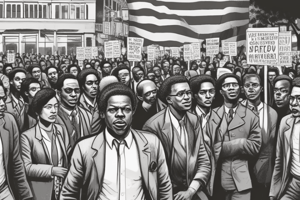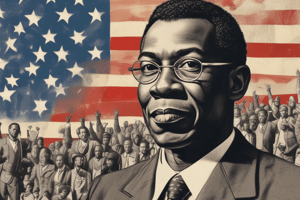Podcast
Questions and Answers
What does the Equality Act 2010 primarily aim to achieve?
What does the Equality Act 2010 primarily aim to achieve?
- To establish a national healthcare system
- To create a framework for public service jobs
- To consolidate anti-discrimination laws (correct)
- To increase tax rates for higher income brackets
Which of the following is NOT a protected characteristic under the Equality Act 2010?
Which of the following is NOT a protected characteristic under the Equality Act 2010?
- Race
- Political affiliation (correct)
- Sexual orientation
- Pregnancy and maternity
What has been a significant area of focus regarding civil rights efforts?
What has been a significant area of focus regarding civil rights efforts?
- Animal rights
- Corporate rights
- Environmental rights
- Race relations (correct)
What issue complicates the discussion of civil rights in the UK?
What issue complicates the discussion of civil rights in the UK?
What type of measures are implemented to protect LGBTQ+ rights in the UK?
What type of measures are implemented to protect LGBTQ+ rights in the UK?
Which government action is taken to ensure compliance with civil rights legislation?
Which government action is taken to ensure compliance with civil rights legislation?
What historical milestone concerning civil rights occurred in the UK?
What historical milestone concerning civil rights occurred in the UK?
What challenges do civil rights laws face in contemporary society?
What challenges do civil rights laws face in contemporary society?
Flashcards
UK Civil Rights
UK Civil Rights
The struggle for equality and justice for various groups in the UK throughout history, culminating in laws and policies.
Equality Act 2010
Equality Act 2010
A key law that combined and expanded UK anti-discrimination laws, protecting people from unfair treatment.
Protected Characteristics
Protected Characteristics
Categories of people the Equality Act 2010 protects against discrimination (age, disability, gender, religion, etc).
Race Relations
Race Relations
Signup and view all the flashcards
Gender Equality
Gender Equality
Signup and view all the flashcards
Disability Rights
Disability Rights
Signup and view all the flashcards
LGBTQ+ Rights
LGBTQ+ Rights
Signup and view all the flashcards
Civil Rights Enforcement
Civil Rights Enforcement
Signup and view all the flashcards
Ongoing Civil Rights Challenges
Ongoing Civil Rights Challenges
Signup and view all the flashcards
Study Notes
Historical Context
- The concept of civil rights in the UK has evolved significantly over time, with struggles for equality and justice playing out across various societal groups.
- Early milestones include the abolition of slavery and the gradual extension of voting rights.
- The 20th century saw significant legal and social reforms aimed at tackling discrimination based on factors like race, ethnicity, gender, and sexual orientation.
- Following World War II, significant social and political change led to a greater focus on civil liberties.
Key Legislation and Acts
- The Equality Act 2010 serves as a foundational piece of legislation, consolidating various anti-discrimination laws and extending protection against unfair treatment.
- The act covers several protected characteristics (age, disability, gender reassignment, marriage and civil partnership, pregnancy and maternity, race, religion or belief, sex, and sexual orientation).
- Other important legislation has addressed specific historical inequalities, including laws regarding race relations, gender equality, and disability rights.
Key Areas of Focus
- Race relations: Legislation and initiatives have been developed to address racial discrimination and promote equality and diversity.
- Gender equality: Efforts have been made to improve women's rights and opportunities, from equal pay to tackling gender-based violence.
- Disability rights: Laws and social programs have aimed at removing barriers and promoting inclusion for individuals with disabilities.
- LGBTQ+ rights: Significant progress has been made in recent decades, with laws protecting LGBTQ+ individuals from discrimination and promoting their rights.
Contemporary Issues
- Despite progress, certain challenges persist in the UK in terms of actual implementation and enforcement of civil rights laws.
- There are ongoing societal and political debates about the extent and nature of equality and inclusion.
- Issues of inequality across social class, region, and socioeconomic factors add complexity to the discussion of civil rights.
- Instances of discrimination and prejudice in areas like employment, housing, and access to services continue to be reported.
Enforcement and Monitoring
- Government agencies and independent bodies play roles in monitoring compliance with civil rights legislation and investigating reported violations.
- Legal avenues allow individuals to challenge discriminatory practices.
- Public awareness campaigns are used to promote understanding and combat discrimination in society.
Future Directions
- The pursuit of equality and justice remains an ongoing process and a continual concern.
- Continuous review of current legislation and ongoing challenges of implementation will likely shape the future landscape.
- Further considerations regarding the intersectionality of experiences and the evolving societal landscape will likely influence future policy development and initiatives.
Studying That Suits You
Use AI to generate personalized quizzes and flashcards to suit your learning preferences.





